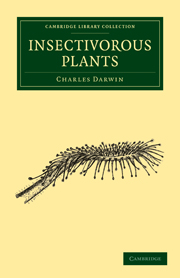Book contents
- Frontmatter
- Contents
- CHAPTER I DROSERA ROTUNDIFOLIA, OR THE COMMON SUN-DEW
- CHAPTER II THE MOVEMENTS OF THE TENTACLES FROM THE CONTACT OF SOLID BODIES
- CHAPTER III AGGREGATION OF THE PROTOPLASM WITHIN THE CELLS OF THE TENTACLES
- CHAPTER IV THE EFFECTS OF HEAT ON THE LEAVES
- CHAPTER V THE EFFECTS OF NON-NITROGENOUS AND NITROGENOUS ORGANIC FLUIDS ON THE LEAVES
- CHAPTER VI THE DIGESTIVE POWER OF THE SECRETION OF DEOSERA
- CHAPTER VII THE EFFECTS OF SALTS OF AMMONIA
- CHAPTER VIII THE EFFECTS OF VARIOUS OTHER SALTS, AND ACIDS, ON THE LEAVES
- CHAPTER IX THE EFFECTS OF CERTAIN ALKALOID POISONS, OTHER SUBSTANCES AND VAPOURS
- CHAPTER X ON THE SENSITIVENESS OF THE LEAVES, AND ON THE LINES OF TRANSMISSION OF THE MOTOR IMPULSE
- CHAPTER XI RECAPITULATION OF THE CHIEF OBSERVATIONS ON DROSERA ROTUNDIFOLIA
- CHAPTER XII ON THE STRUCTURE AND MOVEMENTS OF SOME OTHER SPECIES OF DROSERA
- CHAPTER XIII DIONÆA MUSCIPULA
- CHAPTER XIV ALDROVANDA VESICULOSA
- CHAPTER XV DROSOPHYLLUM — RORIDULA — BYBLIS — GLANDULAR HAIRS OF OTHER PLANTS — CONCLUDING REMARKS ON THE DROSERACEÆ
- CHAPTER XVI PINGUICULA
- CHAPTER XVII UTRICULARIA
- CHAPTER XVIII UTRICULARIA (continued)
- ERRATA
- INDEX
CHAPTER I - DROSERA ROTUNDIFOLIA, OR THE COMMON SUN-DEW
Published online by Cambridge University Press: 29 August 2010
- Frontmatter
- Contents
- CHAPTER I DROSERA ROTUNDIFOLIA, OR THE COMMON SUN-DEW
- CHAPTER II THE MOVEMENTS OF THE TENTACLES FROM THE CONTACT OF SOLID BODIES
- CHAPTER III AGGREGATION OF THE PROTOPLASM WITHIN THE CELLS OF THE TENTACLES
- CHAPTER IV THE EFFECTS OF HEAT ON THE LEAVES
- CHAPTER V THE EFFECTS OF NON-NITROGENOUS AND NITROGENOUS ORGANIC FLUIDS ON THE LEAVES
- CHAPTER VI THE DIGESTIVE POWER OF THE SECRETION OF DEOSERA
- CHAPTER VII THE EFFECTS OF SALTS OF AMMONIA
- CHAPTER VIII THE EFFECTS OF VARIOUS OTHER SALTS, AND ACIDS, ON THE LEAVES
- CHAPTER IX THE EFFECTS OF CERTAIN ALKALOID POISONS, OTHER SUBSTANCES AND VAPOURS
- CHAPTER X ON THE SENSITIVENESS OF THE LEAVES, AND ON THE LINES OF TRANSMISSION OF THE MOTOR IMPULSE
- CHAPTER XI RECAPITULATION OF THE CHIEF OBSERVATIONS ON DROSERA ROTUNDIFOLIA
- CHAPTER XII ON THE STRUCTURE AND MOVEMENTS OF SOME OTHER SPECIES OF DROSERA
- CHAPTER XIII DIONÆA MUSCIPULA
- CHAPTER XIV ALDROVANDA VESICULOSA
- CHAPTER XV DROSOPHYLLUM — RORIDULA — BYBLIS — GLANDULAR HAIRS OF OTHER PLANTS — CONCLUDING REMARKS ON THE DROSERACEÆ
- CHAPTER XVI PINGUICULA
- CHAPTER XVII UTRICULARIA
- CHAPTER XVIII UTRICULARIA (continued)
- ERRATA
- INDEX
Summary
During the summer of 1860, I was surprised by finding how large a number of insects were caught by the leaves of the common sun-dew (Drosera rotundifolia) on a heath in Sussex. I had heard that insects were thus caught, but knew nothing further on the subject. I gathered by chance a dozen plants, bearing fifty-six fully expanded leaves, and on thirty-one of these dead insects or remnants of them adhered; and, no doubt, many more would have been caught afterwards by these same leaves, and still more by those as yet not expanded. On one plant all six leaves had caught their prey; and on several plants very many leaves had caught more than a single insect. On one large leaf I found the remains of thirteen distinct insects. Flies (Diptera) are captured much oftener than other insects. The largest kind which I have seen caught was a small butterfly (Cænonympha pamphilus); but the Rev. H. M. Wilkinson informs me that he found a large living dragon-fly with its body firmly held by two leaves. As this plant is extremely common in some districts, the number of insects thus annually slaughtered must be prodigious. Many plants cause the death of insects, for instance the sticky buds of the horse-chestnut (Æsculus hippocastanum), without thereby receiving, as far as we can perceive, any advantage; but it was soon evident that Drosera was excellently adapted for the special purpose of catching insects, so that the subject seemed well worthy of investigation.
- Type
- Chapter
- Information
- Insectivorous Plants , pp. 1 - 18Publisher: Cambridge University PressPrint publication year: 2009First published in: 1875



